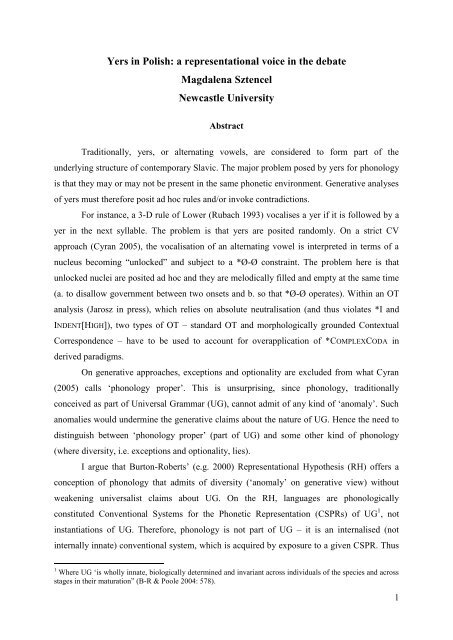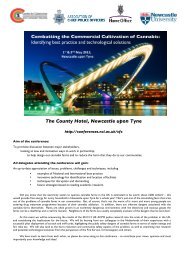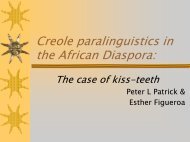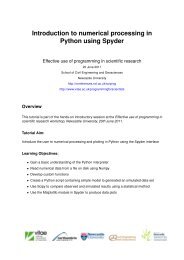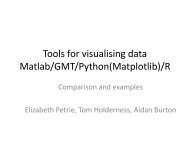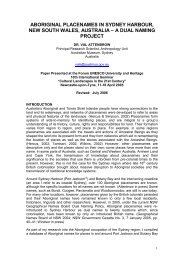Yers in Polish: a representational voice in the debate
Yers in Polish: a representational voice in the debate
Yers in Polish: a representational voice in the debate
You also want an ePaper? Increase the reach of your titles
YUMPU automatically turns print PDFs into web optimized ePapers that Google loves.
<strong>Yers</strong> <strong>in</strong> <strong>Polish</strong>: a <strong>representational</strong> <strong>voice</strong> <strong>in</strong> <strong>the</strong> <strong>debate</strong><br />
Magdalena Sztencel<br />
Newcastle University<br />
Abstract<br />
Traditionally, yers, or alternat<strong>in</strong>g vowels, are considered to form part of <strong>the</strong><br />
underly<strong>in</strong>g structure of contemporary Slavic. The major problem posed by yers for phonology<br />
is that <strong>the</strong>y may or may not be present <strong>in</strong> <strong>the</strong> same phonetic environment. Generative analyses<br />
of yers must <strong>the</strong>refore posit ad hoc rules and/or <strong>in</strong>voke contradictions.<br />
For <strong>in</strong>stance, a 3-D rule of Lower (Rubach 1993) vocalises a yer if it is followed by a<br />
yer <strong>in</strong> <strong>the</strong> next syllable. The problem is that yers are posited randomly. On a strict CV<br />
approach (Cyran 2005), <strong>the</strong> vocalisation of an alternat<strong>in</strong>g vowel is <strong>in</strong>terpreted <strong>in</strong> terms of a<br />
nucleus becom<strong>in</strong>g “unlocked” and subject to a *Ø-Ø constra<strong>in</strong>t. The problem here is that<br />
unlocked nuclei are posited ad hoc and <strong>the</strong>y are melodically filled and empty at <strong>the</strong> same time<br />
(a. to disallow government between two onsets and b. so that *Ø-Ø operates). With<strong>in</strong> an OT<br />
analysis (Jarosz <strong>in</strong> press), which relies on absolute neutralisation (and thus violates *I and<br />
INDENT[HIGH]), two types of OT – standard OT and morphologically grounded Contextual<br />
Correspondence – have to be used to account for overapplication of *COMPLEXCODA <strong>in</strong><br />
derived paradigms.<br />
On generative approaches, exceptions and optionality are excluded from what Cyran<br />
(2005) calls „phonology proper‟. This is unsurpris<strong>in</strong>g, s<strong>in</strong>ce phonology, traditionally<br />
conceived as part of Universal Grammar (UG), cannot admit of any k<strong>in</strong>d of „anomaly‟. Such<br />
anomalies would underm<strong>in</strong>e <strong>the</strong> generative claims about <strong>the</strong> nature of UG. Hence <strong>the</strong> need to<br />
dist<strong>in</strong>guish between „phonology proper‟ (part of UG) and some o<strong>the</strong>r k<strong>in</strong>d of phonology<br />
(where diversity, i.e. exceptions and optionality, lies).<br />
I argue that Burton-Roberts‟ (e.g. 2000) Representational Hypo<strong>the</strong>sis (RH) offers a<br />
conception of phonology that admits of diversity („anomaly‟ on generative view) without<br />
weaken<strong>in</strong>g universalist claims about UG. On <strong>the</strong> RH, languages are phonologically<br />
constituted Conventional Systems for <strong>the</strong> Phonetic Representation (CSPRs) of UG 1 , not<br />
<strong>in</strong>stantiations of UG. Therefore, phonology is not part of UG – it is an <strong>in</strong>ternalised (not<br />
<strong>in</strong>ternally <strong>in</strong>nate) conventional system, which is acquired by exposure to a given CSPR. Thus<br />
1 Where UG „is wholly <strong>in</strong>nate, biologically determ<strong>in</strong>ed and <strong>in</strong>variant across <strong>in</strong>dividuals of <strong>the</strong> species and across<br />
stages <strong>in</strong> <strong>the</strong>ir maturation” (B-R & Poole 2004: 578).<br />
1
def<strong>in</strong>ed, phonologies of CSPRs can be expected to produce forms that on standard approaches<br />
would have to be considered ungrammatical. On <strong>the</strong> RH, diversity is assigned its rightful<br />
place with<strong>in</strong> phonology.<br />
Bibliography<br />
Burton-Roberts, N. and Carr, P. (1999) “On speech and natural language”. Language Sciences<br />
21, p.371-406.<br />
Burton-Roberts, N. (2000) “Where and what is phonology”, <strong>in</strong> Burton-Roberts, N. et al. (eds.)<br />
Phonological knowledge: conceptual and empirical issues. Oxford: Oxford University<br />
Press, p.38-66.<br />
Burton-Roberts, N. and Poole, G. (2004) “Syntax vs. phonology: a <strong>representational</strong> approach<br />
to stylistic front<strong>in</strong>g and verb-second <strong>in</strong> Icelandic”. L<strong>in</strong>gua 116, p.562-600.<br />
Carr, P. (2000) “Scientific realism, sociophonetic variation, and <strong>in</strong>nate endowments <strong>in</strong><br />
phonology”, <strong>in</strong> Burton-Roberts, N. et al. (eds.) Phonological knowledge: conceptual and<br />
empirical issues. Oxford: Oxford University Press, p.67-104.<br />
Cyran, E. (2005) “Sound patterns of <strong>Polish</strong>: phonotactic paradoxes at <strong>the</strong> right edge of<br />
words”. Studies <strong>in</strong> <strong>Polish</strong> L<strong>in</strong>guistics 2: p.61-89.<br />
Hale, M., Kissock, M. and Reiss, C. (1997) “On <strong>the</strong> empirical basis of Output-Output<br />
Correspondence”. University of Toronto Work<strong>in</strong>g Papers <strong>in</strong> L<strong>in</strong>guistics 16 (1), p.61-75.<br />
Available from http://r1.chass.utoronto.ca/twpl/pdfs/twpl16-1/TWPL16-1_HaKiRe.pdf<br />
[Accessed 7 January 2008].<br />
Harris, J. and Gussmann, E. (1998) “F<strong>in</strong>al codas: why <strong>the</strong> West was wrong”, <strong>in</strong> Cyran, E. (ed)<br />
Structure and Interpretation. Studies <strong>in</strong> Phonology. Lubl<strong>in</strong>: Folium, p.139-162.<br />
Jarosz, G. (<strong>in</strong> press). “<strong>Polish</strong> yers and <strong>the</strong> f<strong>in</strong>er structure of output-output correspondence”, <strong>in</strong><br />
Proceed<strong>in</strong>gs of <strong>the</strong> Berkeley L<strong>in</strong>guistic Society. Available from<br />
http://pan<strong>the</strong>on.yale.edu/~gjs42/files/BLS.pdf [Accessed 26 October 2007].<br />
Rochoń, M. (2000). Optimality <strong>in</strong> complexity: <strong>the</strong> case of <strong>Polish</strong> consonant clusters. (Studia<br />
grammatica 48). Berl<strong>in</strong>: Akademie Verlag.<br />
Rubach, J. (1993) ”Abstract vowels <strong>in</strong> three-dimensional phonology: <strong>the</strong> yers”. The L<strong>in</strong>guistic<br />
Review 5, p.247-280.<br />
Rubach, J. and Booij, G. (1990) “Syllable structure assignment <strong>in</strong> <strong>Polish</strong>”. Phonology 7,<br />
p.121-158.<br />
Spencer, A. (1986) “A non-l<strong>in</strong>ear analysis of vowel-zero alternations <strong>in</strong> <strong>Polish</strong>”. Journal of<br />
L<strong>in</strong>guistics 22, p.249-280.<br />
2


